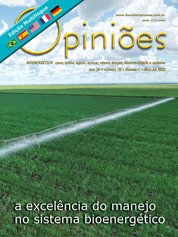Luiz Carlos Dalben
Presidente da Agrícola Rio Claro
OpAA76
A agricultura do sistema sucroenergético
Tudo é energia, ou seja: qualquer atividade praticada pelo homem exige consumo de energia. O sol é sem dúvida a fonte que proporciona a energia ao nosso planeta.
No início da era industrial o homem passou a utilizar carvão como fonte de energia e, posteriormente, com a descoberta oficial do petróleo em 1859 na Pensilvânia por Edwin Drake, passou a desenvolver atividades no campo da mecânica através do uso de combustíveis fósseis.
A descoberta do petróleo proporcionou um grande avanço tecnológico e esta macro fonte de energia moveu e move o planeta até hoje, onde aproximadamente 55% da energia utilizada vem do petróleo, gás natural e seus derivados. Porém, atualmente, a sociedade sente seus efeitos negativos pelo crescente volume utilizado no mundo todo.
Nas últimas décadas, a busca por fontes alternativas, limpas e renováveis vêm se acentuando e a sociedade cobra esta mudança. Os estudos, pesquisas e avanços tecnológicos têm mostrado alguns caminhos promissores para novas fontes ligadas ao agronegócio.
Quando falamos em agricultura e plantas ligadas, itens de biomassa, combustíveis e energia, a primeira cultura que vem a nossa mente é, sem dúvida, a cana-de-açúcar, uma planta C4 com características agronômicas que carrega no seu DNA um potencial que, ao ser transformado pela bioindústria, gera uma gama de produtos que sem dúvida está modificando os conceitos de combustíveis e energia para uma sociedade que cada vez mais exige e pensa em substituir os fósseis pelo renovável e limpo gerador de empregos e desenvolvimentos regionais ou globais.
No Brasil o etanol tem substituído a gasolina desde o final dos anos 70 quando o Proálcool teve início e parte dos motores dos veículos começou a ser adaptada e/ou transformada. Atualmente, no Brasil quase 45% dos veículos que possuem ciclo Otto são movidos a etanol.
O etanol, produzido do caldo pelo esmagamento da cana, tem ganhado um reforço na produção por hectare na própria planta, com a utilização da palha ou complementação ao bagaço na produção do etanol 2G, em fase de crescimento em algumas empresas sucroenergéticas.
O etanol também tem sido estudado e testado como fonte de matéria-prima para produção de hidrogênio verde para utilização em veículos híbridos. Essa tecnologia, associada a outras dificuldades que os carros elétricos enfrentam, deverá encerrar completamente o conceito de carros puramente elétricos.
Relacionado à movimentação de motores, o setor aponta para o biodiesel, gerado, também, a partir da cana-de-açúcar. O potencial dessa planta pode ser confirmado se consideramos que um hectare produz 80 toneladas de cana. Portanto, obtemos por hectare 21 t de bagaço a 1.800kcal/kg, considerando que 1 t de bagaço em caldeira de alta pressão gera 1/2 MW/h.
Nesse mesmo hectare, temos mais de 7.000 l de etanol, 68m3 de vinhaça, que de vilã no passado tem atualmente múltiplas opções de uso, como gerar o biometano para mover motores ciclo diesel ou como fertilizante, possuindo aproximadamente 3 quilos de potássio por metro cubico, o suficiente para suprir mais de um hectare com este nutriente, além de proporcionar grande economia na fertilização dos solos em socas e plantio. Atualmente, com a distribuição da vinhaça localizada, podemos expandir as áreas de aplicação desse produto. Temos, ainda, aproximadamente 12 t de palha que fica no campo após a colheita mecanizada e que ao secar (13% umidade) gera 3.700 kcal/kg.
No processamento da cana-de-açúcar pela indústria, além dos itens já citados, temos outros subprodutos nobres, como a torta de filtro em volume considerável, quando nos referimos a fertilizantes orgânicos ricos em Fósforo, matéria orgânica e com traços de micronutriente. Os números mostram o grande potencial energético da cultura da cana-de-açúcar que, associada às tecnologias que têm sido pesquisadas e desenvolvidas em parceria com Usinas e fabricantes, demonstra claramente que sua participação na matriz renovável e limpa tem garantido um lugar de destaque ao Brasil.
Este setor, no qual convivemos há muitos anos, tem se ramificado para quase todos os estados do Brasil, onde existem diversidades de solo, clima, entre outras. Certamente, há dificuldades para melhorar sua produtividade, pois sendo uma cultura semi perene e passando pelas quatros estações do ano durante seu ciclo, demonstra, sem dúvida, os cuidados necessários de manutenção da lavoura para se obter produtividade economicamente viável.
A eliminação da queima nos canaviais mudou completamente a biologia desse, ambiente favorecendo o ressurgimento de pragas, doenças e novas ervas invasoras. Isso exige mudanças na metodologia de aplicação de insumos; novas moléculas e fórmulas são necessárias e exigem alto grau de conhecimento.
A mecanização plena e tecnologicamente atualizada se faz necessária devido a muitos fatores que vão desde redução de custos de produção, rendimentos operacionais, legislação vigente, atualização de tecnologia, entre tantos outros.
Isso nos demanda um planejamento e, principalmente, uma busca de conhecimento técnico sobre a atividade mecanizada, pois, além de seu alto valor na produção da cana (cerca de 70% dos custos) trafega-se no mesmo hectare de 22 a 25 vezes no ciclo da cultura com equipamentos pesados. A compactação dos solos e injúrias na soqueira, associada a constantes erros operacionais e de adequação de equipamentos, são um dos grandes fatores de redução na produtividade e de aumento nos custos.
Devido às adversidades, é costume dizer: “Nunca uma safra é igual a outra”. Por isso, há necessidade de constante adequação.
A cultura da cana é, sem dúvida, uma fonte de alimentos e energia renovável que está disponível para países como o Brasil, que possui grandes áreas, topografia adequada e condições climáticas favoráveis ao seu desenvolvimento.




